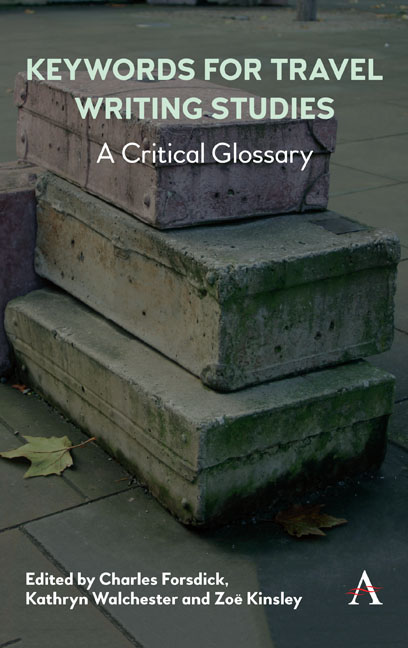Book contents
- Frontmatter
- Contents
- Notes on Contributors
- Introduction
- 1 Abroad
- 2 Adventure
- 3 Aesthetic
- 4 Affect
- 5 Anthropology
- 6 Arrival
- 7 Beaten Track
- 8 Body
- 9 Border
- 10 Boredom
- 11 Breakdown
- 12 Cartography
- 13 City
- 14 Class
- 15 Clothing
- 16 Coevalness
- 17 Colonialism
- 18 Companion
- 19 Contact Zone
- 20 Counterpoint
- 21 Curiosity
- 22 Dark Tourism
- 23 Death
- 24 Diaspora
- 25 Disability
- 26 Domestic Ritual
- 27 End-of-Travel
- 28 Ethics
- 29 Ethnicity
- 30 Exotic
- 31 Extreme Travel
- 32 Fiction
- 33 Form
- 34 Gender
- 35 Genre
- 36 Ghosts
- 37 Grand Tour
- 38 Hearing
- 39 History
- 40 Home
- 41 Home Tour
- 42 Humour
- 43 Identity
- 44 Illustration
- 45 Intermediaries
- 46 Intertextuality
- 47 Islands
- 48 Local Colour
- 49 Margins
- 50 Memory
- 51 Migration
- 52 Minority
- 53 Mobility
- 54 Monarch-of-All-I-Survey
- 55 Money
- 56 Motivation
- 57 Nation
- 58 Nature
- 59 Nomadism
- 60 Orientalism
- 61 Pedestrianism
- 62 Persona
- 63 Picturesque
- 64 Pilgrimage
- 65 Place
- 66 Poetics
- 67 Politics
- 68 Polygraphy
- 69 Primitivism
- 70 Psychoanalysis
- 71 Psychogeography
- 72 Reading
- 73 Science
- 74 Self
- 75 Semiotics
- 76 Sex/Sexuality
- 77 Skin
- 78 Slowness
- 79 Smell
- 80 Solitude
- 81 Subjectivity
- 82 Sublime
- 83 Taste
- 84 Technology
- 85 Time
- 86 Tourism
- 87 Trade
- 88 Translation
- 89 Transport
- 90 Travel
- 91 Traveller/Travellee
- 92 Utopia
- 93 Velocity
- 94 Vertical Travel
- 95 Virtual Travel
- 96 Vision
- 97 War
- 98 Water
- 99 Wonder
- 100 World
- Bibliography
23 - Death
Published online by Cambridge University Press: 13 July 2019
- Frontmatter
- Contents
- Notes on Contributors
- Introduction
- 1 Abroad
- 2 Adventure
- 3 Aesthetic
- 4 Affect
- 5 Anthropology
- 6 Arrival
- 7 Beaten Track
- 8 Body
- 9 Border
- 10 Boredom
- 11 Breakdown
- 12 Cartography
- 13 City
- 14 Class
- 15 Clothing
- 16 Coevalness
- 17 Colonialism
- 18 Companion
- 19 Contact Zone
- 20 Counterpoint
- 21 Curiosity
- 22 Dark Tourism
- 23 Death
- 24 Diaspora
- 25 Disability
- 26 Domestic Ritual
- 27 End-of-Travel
- 28 Ethics
- 29 Ethnicity
- 30 Exotic
- 31 Extreme Travel
- 32 Fiction
- 33 Form
- 34 Gender
- 35 Genre
- 36 Ghosts
- 37 Grand Tour
- 38 Hearing
- 39 History
- 40 Home
- 41 Home Tour
- 42 Humour
- 43 Identity
- 44 Illustration
- 45 Intermediaries
- 46 Intertextuality
- 47 Islands
- 48 Local Colour
- 49 Margins
- 50 Memory
- 51 Migration
- 52 Minority
- 53 Mobility
- 54 Monarch-of-All-I-Survey
- 55 Money
- 56 Motivation
- 57 Nation
- 58 Nature
- 59 Nomadism
- 60 Orientalism
- 61 Pedestrianism
- 62 Persona
- 63 Picturesque
- 64 Pilgrimage
- 65 Place
- 66 Poetics
- 67 Politics
- 68 Polygraphy
- 69 Primitivism
- 70 Psychoanalysis
- 71 Psychogeography
- 72 Reading
- 73 Science
- 74 Self
- 75 Semiotics
- 76 Sex/Sexuality
- 77 Skin
- 78 Slowness
- 79 Smell
- 80 Solitude
- 81 Subjectivity
- 82 Sublime
- 83 Taste
- 84 Technology
- 85 Time
- 86 Tourism
- 87 Trade
- 88 Translation
- 89 Transport
- 90 Travel
- 91 Traveller/Travellee
- 92 Utopia
- 93 Velocity
- 94 Vertical Travel
- 95 Virtual Travel
- 96 Vision
- 97 War
- 98 Water
- 99 Wonder
- 100 World
- Bibliography
Summary
Although death may not be the main thing on the mind of tourists, it is regularly encountered intentionally and incidentally on journeys and tours. Understanding these encounters involves recognizing two of death's defining features. The first is its unknowability. Though dying can be observed and tracked, death cannot since the dead never report back. Death has, therefore, mainly been defined by lexicographers as deficit rather than content – ‘the extinction of life’ (Johnson 1785, no pagination; emphasis added), or ‘the state of being no longer alive’ (Webster's Third New International Dictionary 1971, 581). Medical practitioners identify death by multiple physiological deficits – for example, without breathing, without pulse, without brain activity
Its second feature is that, since death is unknowable, it can only be apprehended through representations and narratives, including those in myths, religious beliefs, paintings, memorials and funerary ceremonies, which constitute the symbolic imaginary of death that travellers may encounter in travel. Until recently these were hardly explored in thanatology studies, a multidisciplinary field that greatly expanded from the 1970s, largely stimulated by the pioneering work of Philippe Aries (1974, 1981 and 1985). His work opened up a flood of studies on death in different cultures (Farrell 1980; Gittings 1984; Jalland 2002; Merridale 2000) and over different time periods (Cecil 1991; Laderman 1996; Tenenti 2002), as well as general overviews that included other factors such as medical and ethical aspects of dying (Watkins 2013; Spellman 2014). None examined connections between death and travel. This linkage came about in the 1990s with the inauguration of a tourism studies subset, variously known as ‘Dark Tourism’ (Lennon 1996) or ‘thanatourism’ (Seaton 1996). The two terms are synonymous in substance, but not in their connotations or their acceptance by some sectors of the tourism industries (see Seaton and Lennon 2004; and Seaton et al. 2015, for a discussion of the debate about the names).
- Type
- Chapter
- Information
- Keywords for Travel Writing StudiesA Critical Glossary, pp. 66 - 68Publisher: Anthem PressPrint publication year: 2019



